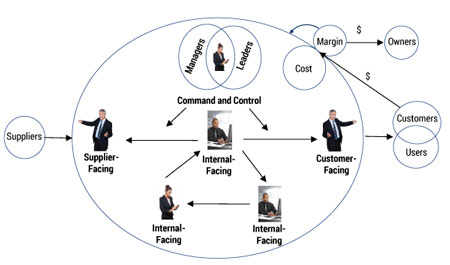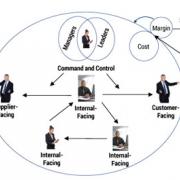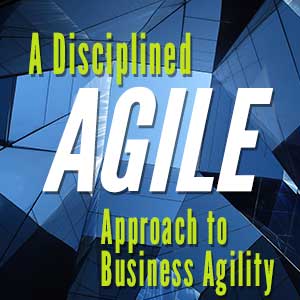Itamae (pronounced “it-ta-ma yeh”) is the Japanese word for sushi chef. If you return to the restaurant of a master sushi chef, the chef will show respect by placing a dish in front of you before you even look at the menu. When you ask, “How did you know I would like this?” the chef will reply, “Of course I knew you would like it — you are my customer.” Under the concept of itamae, a customer is someone whose delights you can anticipate, while a buyer is someone you hope will see economic value in what you have already built. The future versus the past. External versus internal. Does your organization have customers or buyers? If you have customers, you’re focused on their future delight. Since the future is uncertain, agility is required.
In this Advisor, we explore the concept of itamae and the role of leadership on the road to agility.
We can make the discussion of traditional and Agile approaches more specific by relating these concepts to an abstracted view of the organization. Let’s briefly review this abstraction in Figure 1. The right side of the figure distinguishes between customers and users while acknowledging their overlap. Customers are those who pay for the organization’s products and services while users are, obviously, the hands-on users of those products and services. Sometimes they are one and the same. Someone with a Spotify account is both a customer and a user of Spotify’s products and services. In contrast, when SAP sells an HR system to Ford, Ford is the customer, while the users are Ford employees who will use the new system to access job postings, accrued vacation time, 401K balance, and so on. Money flows from the customers back to the organization where it covers the cost of operations and generates margin (profit), which in turn flows to the owners or back to the business as an investment. Within the organization are people who face the customer, people who face the suppliers, people who face each other, along with managers and leaders. As a first step in understanding how your organization (and your professional life) can increase agility, draw a picture of your organizational sphere of influence with you as the customer-facing employee. Identify your customers. Identify the users of what you provide. With this picture of the organization, and you in it, we can more easily identify what can make it Agile.

People Who Face the Customer
The first question for this group is: do we have customers or buyers? When the organization claims to have customers, it must back up this claim with an understanding of the needs of both the customer and user as well as a willingness to collaborate to deepen this understanding. This deepened understanding allows the organization to provide new products and new product features in response to what delights customers. If the organization has buyers, the emphasis is on convincing those buyers to appreciate the economic value of what has been produced. An organization with buyers better have a very good product.
Consider two products at these extremes. The GE jet turbine is an engineering marvel — a product with unbelievable manufacturing tolerances and performance parameters that only a select group of engineering specialists can understand and achieve. The cost of entry for additional competitors is prohibitive. GE has buyers for this product and therefore its investment must be concentrated on the product itself. At the right price buyers will come. On the other hand, consider IKEA furniture and the IKEA store. Here, customer delight rules, and other suppliers can easily enter the market. Thus, IKEA’s investment must be tailored to the needs of its users. While IKEA designers are adding food kiosks to allow young families, with kids in tow, to make the most of their Saturday afternoon outing, GE jet engine designers are increasing the pressure ratio behind a set of fan blades rotating at 30,000 rpm. Successful businesses balance their efforts across this spectrum. Unfortunately, many businesses think they sell “jet engines” (and focus their efforts accordingly) when they really sell “furniture.” They make this error at their peril.
Think of the Encyclopedia Britannica and the knowledge contained in paper, Sears and the novelty of the mall, Kodak and the wonders of Kodachrome … the list goes on. If you think you’re selling “jet engines,” you might be right for a period of time, but history tells us that in the long run you are probably wrong. In short, Agile organizations have customer-facing teams that understand the makeup of the customer/user community they serve and are actively collaborating with this community (especially the users) to provide business value.
A final note on IKEA: A business journalist had arranged to meet Ingvar Kamprad, the founder and owner of IKEA, at his Stockholm store. The journalist showed up on time, but Ingvar was not in his office. The IKEA staff told the journalist to look in the usual place the boss could be found — the customer checkout line. That’s a lasting image of curiosity about what delights the customer.
People Who Face Each Other
Do people who face each other have internal customers or buyers? Answer: they only have customers. There are no internal “jet engines”; internal activities are cost centers. If an internal-facing group thinks they have buyers of their wonderful process, they are a stove-pipe consuming cost rather than generating benefit. For example, consider a traditional project management office (PMO) that now has oversight of recently initiated Agile projects. Should the PMO require the same status-reporting template and earned value management cost reports for all projects? Standardization has its place and in command-and-control organizations it is generally embraced. However, does standardization make the jobs of the company’s project managers (especially Agile project managers) easier or harder? In an Agile world, we start with what makes a successful project manager, what would delight an overworked project manager, and how we can provide more time for interaction with the customer. After we understand the project manager’s world, we begin the process of improving it.
Consider the HR-driven annual performance review process in which a bell curve is applied to all employees: 10% must be told to improve, 10% must be told they are outstanding, and the rest are told they are average. Countless hours are spent by management and employees preparing for this, often dreaded, annual meeting. But where is the delighted customer in this process? Many organizations are thankfully leaving this annual “jet engine” behind and encouraging managers to provide continuous motivation and feedback to employees.
Internal processes must be assessed on whether we can identify specific customers, whether we are collaborating with these customers, and whether we are bringing business value to these customers at the lowest cost possible. If the customer is an entrenched silo protecting its domain irrespective of business value, we are on the wrong track.
People Who Face Suppliers
People who face suppliers should consider themselves customers of the suppliers’ product rather than buyers of the product. This requires an open relationship that allows a common understanding of the issues facing the organization — no hidden agendas aimed only at achieving the lowest price. Collaboration rather than contracts should rule. This collaboration should result in a chain of supply capable of responding to changing needs in a manner that expedites delivery of ordered goods and services to customers. The recent trend to cloud computing provides an excellent opportunity for organizations and cloud suppliers to practice itamae. People who face cloud suppliers should be transparent about the organization’s needs, kill any “not invented here” mindsets, and expect to be delighted.
People Who Are Managers and Leaders
The overlap of managers and leaders shown in Figure 1 deserves some comment. Managers have subordinates and ensure tasks are completed through the application of processes and procedures. Leaders have followers and influence people to excel through the articulation of a future state in which all benefit. Managers can be leaders, but leaders need not be managers and can exist at any level within the organization.
The first impediment to agility for managers, especially C-suite managers, is when they articulate their goals in terms of the deliverable that “makes the world go ’round” — that is, cash. Concentration on short-term financial benefits without recognition that the cash comes from customers (who must be delighted, or they will not become, or remain, customers) is not a strategy for organizational success. If this sounds naive, consider Amazon CEO Jeff Bezos. He became the richest person in the known universe in 21 short years by concentrating on customer delight rather than company margin and dividends. Indeed, by keeping margins razor-thin and paying no dividend, Amazon put itself in the best competitive position possible, discouraging would-be entrants to the industry and building up long-term market share.
The next impediment to agility for managers is the reliance on command and control, which implies a hierarchical approach to advancing business interests. Those in control (at the top of the hierarchy) command those below them. However, under the concept of itamae, the delight of customers is best advanced by those closest to the customer. Empowering the people who face the customer to drive business decisions is a hallmark of the Agile organization.
[For more from the author on this topic, see “Itamae, the Agile Organization, and You” from the Cutter Business Technology Journal report, A Disciplined Agile Approach to Business Agility]
A Disciplined Agile Approach to Business Agility
This report provides guidance on optimizing the entire enterprise, lowering risk, and accelerating the journey to business agility. Use Code DAD20 to Save 20%. Learn more or order now!



